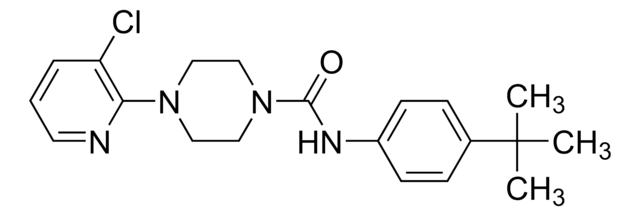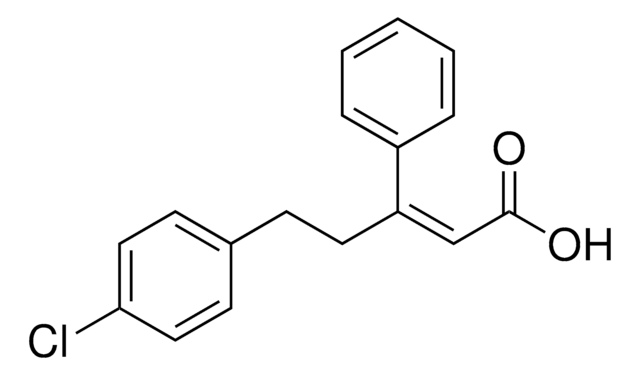SML1600
Rinvanil
≥98% (HPLC)
Synonym(e):
(9Z,12R)-12-Hydroxy-N-[(4-hydroxy-3-methoxyphenyl)methyl]-9-octadecenamide, N-Vanillylricinoleamide
Anmeldenzur Ansicht organisationsspezifischer und vertraglich vereinbarter Preise
Alle Fotos(1)
About This Item
Empirische Formel (Hill-System):
C26H43NO4
CAS-Nummer:
Molekulargewicht:
433.62
UNSPSC-Code:
12352200
NACRES:
NA.77
Empfohlene Produkte
Biochem./physiol. Wirkung
Rinvanil is a Capsaicin analogue that potently activates transient receptor potential vanilloid 1 (TRPV1) channels. Rinvanil induces neuroprotective mild hypothermia in ischemic brain injured mice through TRPV1 activation. Rinvanil exhibits potent anticancer activity in cancer cell lines including cervical (HeLa, CaSKi, ViBo) and leukemia (P388, J774, WEHI-3) cell lines. Rinvanil is not cytotoxic to normal lymphocytes.
TRPV1 (transient receptor potential vanilloid 1) is a capsaicin receptor. It is strongly expressed in sensory neurons and participates in pain perception. In brain, it regulates neuronal function, motor behaviour and neuroinflammation. Capsaicin plays an important role in the activation of TRPV1.
Lagerklassenschlüssel
10 - Combustible liquids
WGK
WGK 3
Flammpunkt (°F)
Not applicable
Flammpunkt (°C)
Not applicable
Analysenzertifikate (COA)
Suchen Sie nach Analysenzertifikate (COA), indem Sie die Lot-/Chargennummer des Produkts eingeben. Lot- und Chargennummern sind auf dem Produktetikett hinter den Wörtern ‘Lot’ oder ‘Batch’ (Lot oder Charge) zu finden.
Besitzen Sie dieses Produkt bereits?
In der Dokumentenbibliothek finden Sie die Dokumentation zu den Produkten, die Sie kürzlich erworben haben.
Jin H Nam et al.
Brain : a journal of neurology, 138(Pt 12), 3610-3622 (2015-10-23)
Currently there is no neuroprotective or neurorestorative therapy for Parkinson's disease. Here we report that transient receptor potential vanilloid 1 (TRPV1) on astrocytes mediates endogenous production of ciliary neurotrophic factor (CNTF), which prevents the active degeneration of dopamine neurons and
Katy A Freed et al.
Journal of medical genetics, 48(8), 563-566 (2011-05-07)
Cystinosis is an autosomal recessive disease characterised by the abnormal accumulation of lysosomal cystine. Mutations in the cystinosin gene (CTNS) represent known causes for the disease. The major cystinosis mutation is a 57 kb deletion on human chromosome 17p13 that
Unser Team von Wissenschaftlern verfügt über Erfahrung in allen Forschungsbereichen einschließlich Life Science, Materialwissenschaften, chemischer Synthese, Chromatographie, Analytik und vielen mehr..
Setzen Sie sich mit dem technischen Dienst in Verbindung.








